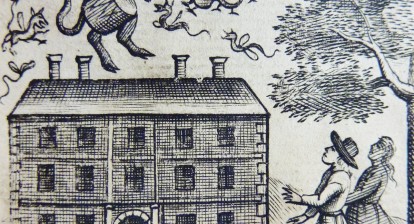Whenever we suddenly encounter something that frightens or startles us, our body has a tendency to “jump” in response. Over the past decade, a considerable amount of evidence has been gathered to suggest that, on a very subtle and unconscious level, our body’s autonomic nervous system may also “jump” in response to frightening or startling stimuli. However, it does so even before our body encounters such stimuli. This evidence comes from various experiments designed to explore the possible physiological signatures of a precognition-related experience that has come to be known as presentiment or pre-stimulus response.
The first presentiment studies were conducted by Dr. Dean Radin (1997, 2004) of the Institute of Noetic Sciences in California. He had his subjects view both affective and neutral pictures being randomly displayed on a computer screen while the electrical activity in the nerve cells of the subjects’ skin was being measured. Affective pictures contain images that draw out a particularly strong emotional reaction in us, whether it is fear or shock (e.g., fatal accidents, murder victims, & threatening animals), or arousal (e.g., erotic images). Neutral pictures are just the opposite – images that tend not to stir our emotions (e.g., landscapes, household items, & fruit). The results of Radin’s studies indicated that the subjects had shown significantly larger changes in skin electrical activity in the moments just before they were shown an affective picture as compared to changes in their activity just before seeing a neutral picture. This suggests that the nervous systems of the subjects were producing an emotional “jump” response to the affective picture before they had even seen it. In other words, it seems to be an emotional response in anticipation of a future event. Follow-up studies suggested that violently-themed affective pictures tend to elicit the strongest presentiment response, and that the response can be stronger when the affective picture is shown for a shorter time (Bierman & Radin, 1997, 1999). A few other independent studies have tried other startling stimuli, such as blasting alarm sounds into the subjects’ ears at random times. These subjects also showed a presentiment response (May et al., 2005; Spottiswoode & May, 2003).
A growing number of recent studies are suggesting that other parts of the body may also show a presentiment response, including the heart (McCraty et al., 2004a) and the brain (Bierman & Scholte, 2002; Bierman & van Ditzhuijzen, 2006; Hinterberger et al., 2006; McCraty et al., 2004b). The results of a study by Radin and Eva Lobach (2007) of the University of Amsterdam, which was published in the latest issue of the Journal of Alternative and Complementary Medicine, seems to add to the evidence for the latter.
In Radin and Lobach’s study, slow brain wave activity was recorded from the occipital region (associated with vision) at the back of their subjects’ brains via electroencephalograph (EEG) while the subjects were visually stimulated at random times. The stimulation came in the form of a light that was quickly flashed toward the subject’s eyes through a pair of opaque glasses fitted with light-emitting diodes (LEDs). To start each individual test trial, the subject clicked a computer mouse that they held in their hands. After 4 seconds (which constituted the presentiment period) had passed, the computer sampled an electronic random number generator to determine whether it should activate the LEDs in the subject’s glasses and produce a flash, or whether it should keep them dark until the end of the trial (indicated by a computer tone), then the process was repeated for the next trial. The probability of the subject seeing the LEDs flash or not was exactly 50/50 for each trial. The EEG results indicated that during the presentiment period, female subjects had shown a slightly higher level of brain wave activity on the trials where the LEDs were flashed than on the trials where the LEDs did not flash to a statistically significant degree (odds of about 142 to 1 against chance alone). This higher level of brain activity during the flash trials suggests a kind of anticipation or “readying” response to the impending light flash, akin to presentiment. Interestingly, male subjects had shown the opposite effect, in that their level of brain wave activity was slightly lower on flash trials than on no flash trials. This latter finding was not statistically significant, however. Radin and Lobach also found that the peak level of brain wave activity for the female subjects occurred approximately one second before the light flash.
Radin and Lobach’s findings are consistent with other brain studies related to presentiment and precognition. Bierman and Scholte (2002) had monitored their subjects’ brain activity using magnetic resonance imaging (MRI) while the subjects randomly viewed affective and neutral pictures. They found that higher levels of brain activity were present in the occipital region just before the subjects viewed affective pictures than when they viewed neutral pictures, a finding consistent with studies on visual processing of affective and neutral pictures (e.g., Lang et al., 1998). McDonough et al. (2002) conducted a series of studies in which they disguised a precognition test in a gambling task. Four playing cards were shown on a computer screen to the subject, and the subject selected one of them. A moment later, the computer randomly chose one of the cards to be the precognition target. EEG monitoring of the subjects during this task revealed higher brain wave activity in subjects when they selected the target card than when they didn’t select it. At least three other EEG studies relating to presentiment have observed similar effects (Bierman & van Ditzhuijzen, 2006; Hinterberger et al., 2006; McCraty et al., 2004b).
A lot of questions still remain about presentiment and precognition as a whole, but these studies strongly hint that there may be a brain correlate of such phenomena, and this is one thing that may eventually help establish their existence, apart from the statistical evidence for them.
– Bryan Williams
References:
Bierman, D. J., & Radin, D. I. (1997). Anomalous anticipatory response on randomized future conditions. Perceptual and Motor Skills 84(2), April. pp. 689 – 690.
Bierman, D. J., & Radin, D. I. (1999). Conscious and anomalous nonconscious emotional processes: A reversal of the arrow of time? In S. R. Hameroff, A. W. Kazniak, & D. J. Chalmers (Eds.) Toward a Science of Consciousness III: The Third TUCSON Discussions and Debates (pp. 367 – 385). Cambridge, MA: MIT Press/Bradford.
Bierman, D. J., & Scholte, H. S. (2002). Anomalous anticipatory brain activation preceding exposure of emotional and neutral pictures. Proceedings of Presented Papers: The Parapsychological Association 45th Annual Convention (pp. 25 – 36). Cary, NC: Parapsychological Association, Inc.
Bierman, D. J., & van Ditzhuijzen, J. (2006). Anomalous slow cortical components in a slot-machine task. Proceedings of Presented Papers: The Parapsychological Association 49th Annual Convention (pp. 5 – 19). Petaluma, CA: Parapsychological Association, Inc.
Hinterberger, T., Studer, P., Jäger, M., Haverty-Stacke, C., & Walach, H. (2006). The slide-show presentiment effect discovered in brain electrical activity. Proceedings of Presented Papers: The Parapsychological Association 49th Annual Convention (pp. 57 – 70). Petaluma, CA: Parapsychological Association, Inc.
Lang, P. J., Bradley, M. M., Fitzsimmons, J. R., Cuthbert, B. N., Scott, J. D., Moulder, B., & Nangia, V. (1998). Emotional arousal and activation of the visual cortex: An fMRI analysis. Psychophysiology 35(2), March. pp. 199 – 210.
May, E. C., Paulinyi, T., & Vassy, Z. (2005). Anomalous anticipatory skin conductance response to acoustic stimuli: Experimental results and speculation about a mechanism. Journal of Alternative and Complementary Medicine 11(4), August. pp. 695 – 702.
McCraty, R., Atkinson, M., & Bradley, R. T. (2004a). Electrophysiological evidence of intuition: Part 1. The surprising role of the heart. Journal of Alternative and Complementary Medicine 10(1), February. pp. 133 – 143.
McCraty, R., Atkinson, M., & Bradley, R. T. (2004b). Electrophysiological evidence of intuition: Part 2. A system-wide process? Journal of Alternative and Complementary Medicine 10(2), April. pp. 325 – 336.
McDonough, B. E., Don, N. S., & Warren, C. A. (2002). Differential event-related potentials to targets and decoys in a guessing task. Journal of Scientific Exploration 16(2), Summer. pp. 187 – 206.
Radin, D. I. (1997). Unconscious perception of future emotions: An experiment in presentiment. Journal of Scientific Exploration 11(2), Summer. pp. 163 – 180.
Radin, D. I. (2004). Electrodermal presentiments of future emotions. Journal of Scientific Exploration 18(2), Summer. pp. 253 – 273.
Radin, D., & Lobach, E. (2007). Toward understanding the placebo effect: Investigating a possible retrocausal factor. Journal of Alternative and Complementary Medicine 13(7), September. pp. 733 – 739.
Spottiswoode, S. J. P., & May, E. C. (2003). Skin conductance prestimulus response: Analyses, artifacts, and a pilot study. Journal of Scientific Exploration 17(4), Winter. pp. 617 – 641.






